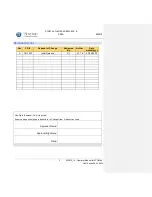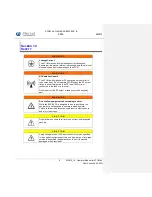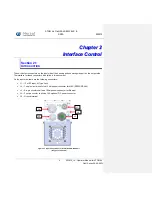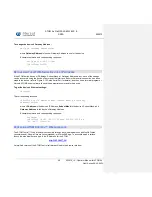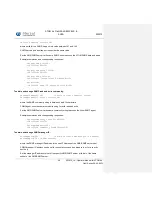
ATOM Ku GaN 20-40-80W BUC &
SSPA
052910
13
052910_rA - Operator Manual for ATOM Ku
GaN Series 20-40-80W
Mute Control: Pin D
This pin controls the hardware mute state of the ATOM. When muted, the power transistors are turned
off, reducing power consumption and providing an RF output noise close to the thermal noise floor.
The operation of this pin is fully configurable through the M&C Interface. Pin D can be biased with either
an internal Pull-Down (to 0V) or an internal Pull-Up (to 4V). Pin D is also configurable to be either active
high (3-5V on Pin D will mute the unit) or active low (0-0.8V on Pin D will mute the unit). All voltages are
relative to Pin G or the Case Ground.
Because of the configurable pull-down / pull-up resistor, the unit can be configured to be active (i.e. not
muted) when Pin D is left floating. Therefore, it is possible to operate the unit with no connection pin D.
The ATOM mute control behavior is shown below in Table 2-2. Note that the ATOM may be factory
ordered with alternate configurations, so the Default configuration shown in the table is not reflective of all
ATOM units.
Table 2-2: ATOM Mute Control Behavior
Configuration
Mute Line
Polarity
Mute Line
Bias
Sample
Input 1
Sample Mute
State 1
Sample
Input 2
Sample Mute
State 2
Sample
Input 3
Sample Mute
State 3
Default
0V = Unmute
Pull-Down
0V
Unmuted
5V
Muted
Floating
Unmuted
Sample 1
0V = Unmute
Pull-Up
0V
Unmuted
5V
Muted
Floating
Muted
Sample 2
5V = Unmute
Pull-Down
0V
Muted
5V
Unmuted
Floating
Muted
Sample 3
5V = Unmute
Pull-Up
0V
Muted
5V
Unmuted
Floating
Unmuted
Note that the ATOM mute state can also be controlled through the M&C interface. The software mute
setting takes priority over the hardware pin. Refer to
for details.
RS-485 Port: Pins A, B, C, J, G
These five pins form a standard four-wire RS-485 serial port, with Rx+, Rx-, Tx+, Tx-, and serial port
ground. Since communication with the ATOM is only half duplex, it is possible to deploy the ATOM on a
two-wire RS-485 network by connecting the Tx+ & Rx+ and Tx- & Rx- wires together.
Tx+ and Tx- are the differential pair which carries a signal from the host computer to the unit. Rx+ and
Rx- are the differential pair which carries a signal from the unit to the host computer. Connect these to
the host computer RS-485 port accordingly.
RS-232 Port: Pins E, F, & G
These pins form a standard RS-232 serial port. Pin F carries a signal from the host computer to the unit
and Pin E carries a signal from the unit to the host computer. Pin G must be connected t o the ground pin
on the host computer.



